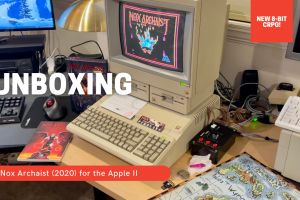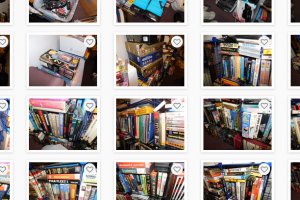As I continue to optimize what remains of my collection, I’ve been focusing a bit lately on my Apple IIe Platinum (after a few hours with a nice multi-cart on my Atari 1200XL). Previously I “fixed” the keyboard, and now I have both a single and dual Mockingboard configuration working (and, after this posting, I set up my CFFA3000 v1.3).
For those who don’t know, the Mockingboard was an expensive add-on card for the Apple II series, first released in 1981. It went through several revisions and clones (including modern recreations) over the years and was really the best way to enhance the Apple II’s meager built-in sound capabilities (of course, the Phasor was no slouch, just hard to find).
As with most add-ons, the catch with the Mockingboard was the lack of support. Here are the known software titles that support it (not counting some modern homebrew stuff, like Alien Clonepure):
- Adventure Construction Set
- Apple Cider Spider (Sierra)
- Berzap! – A clone of the classic arcade game, Berzerk!
- Broadsides (SSI)
- Crimewave – Speech supported
- Crypt of Medea – Speech supported
- Cybernoid Music Disk
- Guitar Master – Guitar tutoring
- Lady Tut, specific Mockingboard version
- Lancaster (Silicon Valley Systems)
- Microbe (Synergistic)
- Mockingboard software (Sweet Micro Systems)
- Mockingboard Developers Kit
- Mockingboard Speech Developers Kit
- Music Construction Set, different revisions do more as released
- Music Star – The OEM version did not support the Mockingboard, it was later patched by the underground to use the Mockingboard instead of the proprietary hardware that shipped with it.
- Night Flight
- One on One – Opening sequence music only
- Phasor software (Applied Engineering)
- Popeye
- Rescue Raiders v1.3 – (SSI263 speech only)
- Silent Service (Microprose)
- Skyfox
- Spy Strikes Back
- Thunder Bombs
- Ultima III, original release did not support the Mockingboard
- Ultima IV
- Ultima V – Supported two Mockingboards
- Under Fire (Ralph Bossom’s)
- Willy Byte
- Zaxxon, specific Mockingboard version
Not a big list and it’s sometimes hard to find the Mockingboard-specific versions. Now, I kept an original, boxed Mockingboard, as well as one of the new Mockingboard v2.1 recreations with slots for the two speech chips, which I also populated (2 x SSI-263P Speech Synthesizer). Unfortunately, despite my best efforts, I could find no way to test the speech. I’m still hoping someone has an answer, because the programs that claim to support speech don’t seem to support it (at least the versions I tried).
I had better luck testing the music capabilities of the Mockingboard v2.1 in slot 4. Most games that said they worked with it – including the Penguin titles that only support the original model of the Mockingboard – worked fine.
Since I’m only aware of one game, Ultima V, that supports two Mockingboards and a full 12 voice soundtrack, I popped the original Mockingboard in slot 5 and decided to give it a go. It turns out that each Mockingboard needs to be connected to its own set of speakers, but I had an ace-in-the-hole with a guitar amplifier, which could take and mix both inputs at the same time. Here’s the result:
Now, to be honest, I really couldn’t tell a great deal of difference between one card with six voices and two cards with 12 voices. It seemed like only occasional notes/additions were played on the secondary card (tested by pulling each plug side), so I don’t even think Ultima V uses all 12 voices. It’s maybe 8 or 9. I could be wrong, though.
As for me, I’m keeping the modern Mockingboard in there and will eventually get around to selling the original Mockingboard. It’s hard enough finding a use for one card, let alone two. Disappointing, but understandable given the cost of these at the time.
UPDATE: Thanks to my shoddy memory, I forgot that Great Hierophant on AtariAge put together a brilliant spreadsheet with far more software support info.






 Your total news and information resource for all things Science, Technology, Engineering / Mathematics, Art, and Medicine / Health.
Your total news and information resource for all things Science, Technology, Engineering / Mathematics, Art, and Medicine / Health.
7 Comments
Leave your reply.